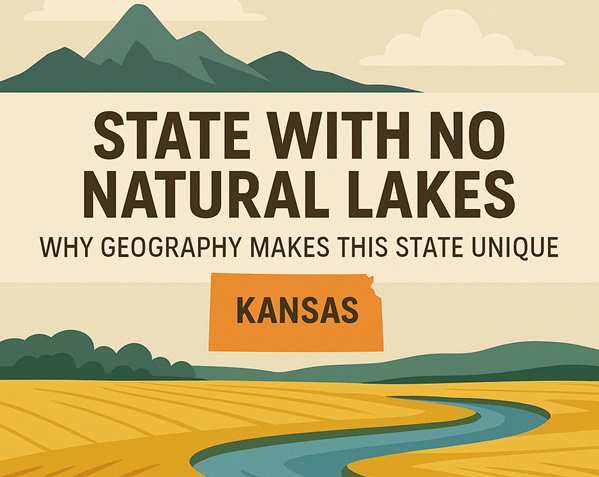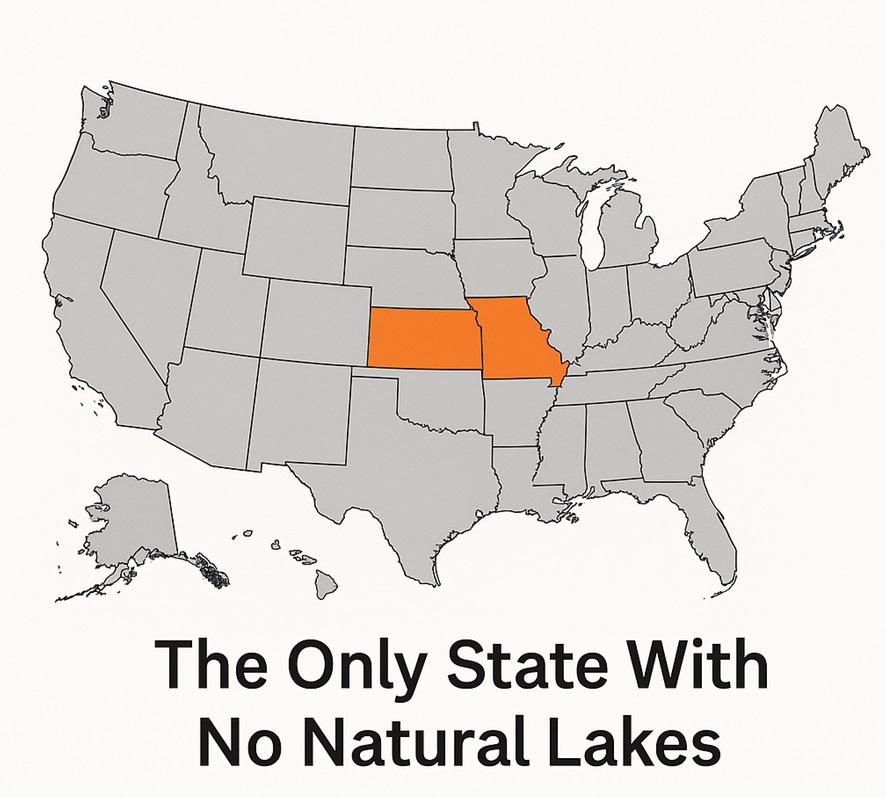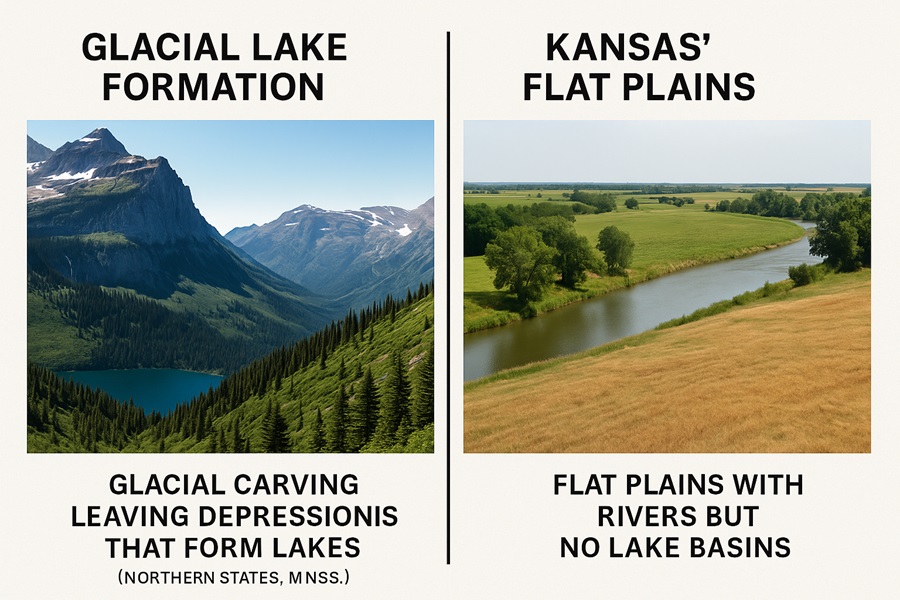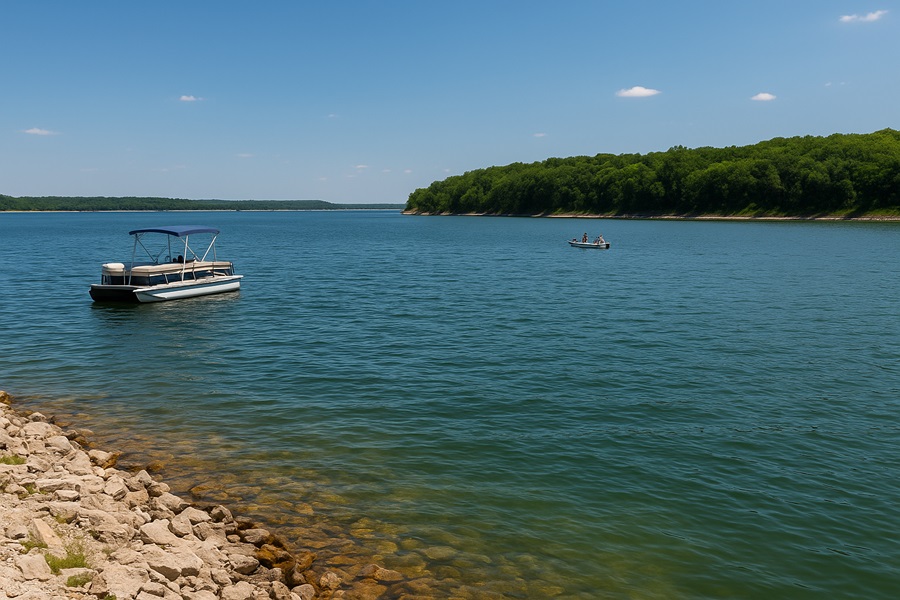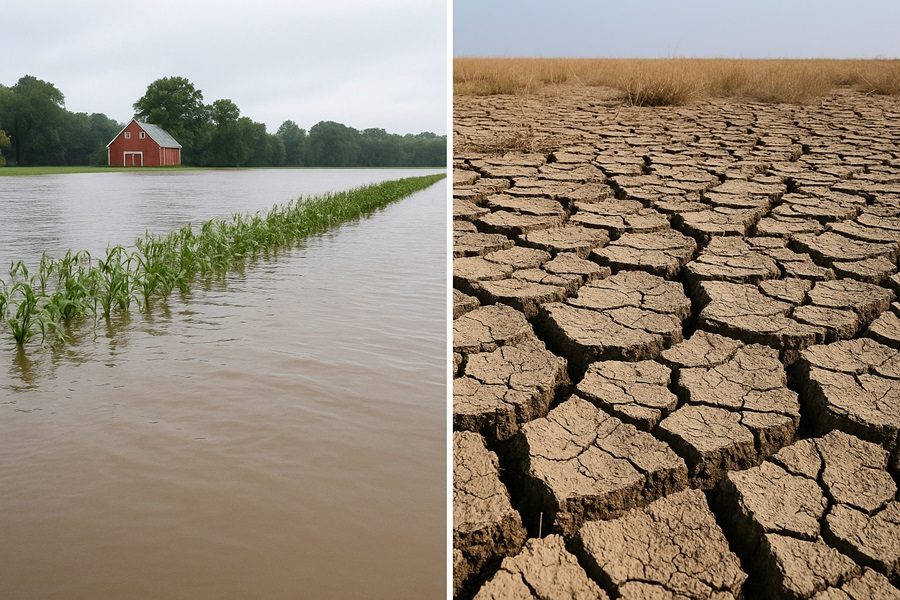The United States is a land of incredible geographic variety — from mountains and deserts to plains and lakes. Scientists say there are over 117 million lakes worldwide and the US has a big chunk of them. Some states, like Minnesota, tout their lakes as part of their brand.
But one state stands out for a weird reason. Known as the State with No Natural Lakes, Kansas is the only state where every lake you see is man-made. This surprises geography students, trivia buffs and even lifelong residents. How can a state so rich in rivers and farmland have zero natural lakes? The answer is in its geology, glacial history and human engineering.
In this post we’ll explore why Kansas has no natural lakes, how reservoirs support its people and why that makes it the only state of its kind.
Which State Has No Natural Lakes?
The only US state with no natural lakes is Kansas.
Most states, even the driest ones, have at least one natural lake. Kansas is the exception. Every body of standing water in the state is artificial — man-made reservoirs, ponds or impoundments.
Quick facts:
- State: Kansas
- Natural Lakes: 0
- Man-Made Lakes/Reservoirs: Over 120
- Major Rivers: Kansas River, Arkansas River, Missouri River
So if you see a “lake” in Kansas, you’re actually looking at a reservoir or impoundment built for flood control, irrigation or recreation.
Answer: The only US state with no natural lakes is Kansas. Every lake in Kansas is man-made.
Recomended Reading : Countries With No Natural Rivers
The Geography of the Mystery
Why doesn’t Kansas have natural lakes when almost every other state does? The answer is in its geology and lack of glacial activity.
- Flat Plains and Soil Composition
Kansas is the “Heartland of America,” flat or gently rolling plains. Unlike northern states that were shaped by glaciers during the last Ice Age, Kansas doesn’t have the deep depressions or basins where lakes form.
- No Glacial Carving
Northern states like Minnesota, Wisconsin, and Michigan were heavily glaciated thousands of years ago. As glaciers advanced and retreated, they scoured the land and left behind basins that later filled with water. Kansas was never glaciated, so its plains don’t have natural lake basins.
- River-Dominated Landscape
Kansas is river-rich. The Kansas River, Arkansas River, and parts of the Missouri River provide plenty of water flow. But rivers carve valleys and channels, not lakes. Water here moves through the land, not into permanent basins.
Deeper Geological History: Why Kansas Never Had Lakes
Kansas’ landscape is millions of years in the making — and the absence of forces that shaped other states.
During the last Ice Age, huge glaciers carved through the northern U.S. and created thousands of lakes. Kansas was south of the glaciation zone and was shaped by erosion and river systems instead.
Over time, the Kansas and Arkansas rivers spread fertile soil across the plains. Good for farming — not for lakes. The state’s porous soil allows water to seep away, preventing natural lakes from forming.
In short: Kansas was built for rivers and plains, not lakes.
Rivers, Reservoirs, and Man-Made Lakes
Even though Kansas has no natural lakes, it has plenty of man-made reservoirs that serve critical roles.
Why Kansas Built Reservoirs
- Flood Control: Flat geography makes Kansas prone to flooding. Reservoirs regulate water flow.
- Water Supply: Reservoirs provide drinking water to millions.
- Irrigation: Agriculture relies on stored water for crops.
- Recreation: Fishing, boating, and camping thrive at reservoir sites.
Major Man-Made Lakes in Kansas
- Tuttle Creek Lake – Flood control & recreation
- Milford Lake – The state’s largest reservoir
- Cheney Reservoir – Wichita’s primary water source
- Clinton Lake – Recreation and water supply for Lawrence
- Perry Lake – Popular for camping & fishing
Every one of these “lakes” is engineered — none formed naturally.
Human Adaptation: Building Kansas’ Water Supply
Since Kansas lacked natural lakes, people engineered solutions. Starting in the 20th century, the U.S. Army Corps of Engineers and Bureau of Reclamation constructed dozens of reservoirs.
Reservoir Development Timeline:
- 1930s–40s: Flood control projects after devastating floods
- 1950s–70s: Major dams built (Milford, Tuttle Creek)
- 1980s–present: Expansion & recreation use
Impact of Reservoirs:
- Tuttle Creek Lake prevents millions in flood damage annually.
- Cheney Reservoir supplies nearly all of Wichita’s drinking water.
- Outdoor recreation around reservoirs adds billions to the state economy.
Kansas turned its lack of natural lakes into a strength — relying on human ingenuity to create lifelines.
Why It Matters: Water, Ecology, and People
The absence of natural lakes doesn’t mean Kansas lacks water — but human intervention plays a larger role.
- Ecology: Reservoirs host fish & bird species but fluctuate more than natural lakes.
- Agriculture: Irrigation from reservoirs powers Kansas’ wheat, corn, and soybean production.
- Drinking Water: Cities like Wichita rely almost entirely on reservoirs.
- Tourism: Fishing tournaments, boating, and camping bring thousands of visitors.
Comparisons With Other States
| State | Natural Lakes | Reservoirs/Man-Made | Key Notes |
| Kansas | 0 | 120+ | Only U.S. state with no natural lakes |
| Minnesota | 11,800+ | 1,000+ | “Land of 10,000 Lakes,” glacial |
| Wisconsin | 15,000+ | 1,000+ | Glacial scouring |
| Florida | 30,000+ | Hundreds | Lakes from sinkholes |
| Texas | 1 (Caddo Lake) | 7,000+ | Nearly all lakes are man-made |
| Nevada | Few | Dozens | Some desert natural lakes |
Even desert states have at least one natural lake. Kansas alone has none.
Climate and Water Management Challenges
Kansas’ lack of natural lakes makes it more vulnerable to climate extremes.
- Droughts: No long-term natural storage; reservoirs can run dangerously low.
- Floods: Heavy rains overwhelm rivers; reservoirs prevent disaster.
Case Study:
- 2011 Floods: Tuttle Creek Reservoir nearly maxed out but saved towns from catastrophe.
- 2023 Drought: Cheney Reservoir dropped to critical levels, threatening Wichita’s water.
Kansas’ reservoirs are more than recreational features — they’re survival tools.
Cultural and Historical Perspectives
- Indigenous Peoples: Tribes like the Kansa and Osage thrived along rivers long before reservoirs.
- European Settlers: Built ponds and clustered communities near rivers.
- Modern Identity: Kansas embraces being the only state with no natural lakes, turning a limitation into a point of state pride.
Myths and Misconceptions
- “Every state has at least one natural lake” → False. Kansas has none.
- Maryland? Has small natural lakes, though its largest are reservoirs.
- Texas? Almost all reservoirs, but Caddo Lake is natural.
- Nevada? Sparse lakes, but still natural ones exist.
- Ponds ≠ Lakes: Many confuse Kansas ponds with lakes, but they are too small to count.
Future Outlook: Kansas and Climate Change
As climate change reshapes the U.S., Kansas faces unique challenges because it lacks natural lakes.
- Hotter summers → longer droughts stressing reservoirs.
- Intense storms → heavier floods may overwhelm dams.
- Aquifer depletion → Ogallala Aquifer shrinking faster than it replenishes.
Possible Solutions:
- Expand reservoirs
- Promote agricultural water conservation
- Protect rivers as natural buffers
- Tie water projects to renewable energy
Quick Trivia Box:
- Q: Which state has no natural lakes? → Kansas
- Q: Why? → Flat geography + no glaciers
- Q: How many reservoirs? → Over 120
Teachers use this fact to spark curiosity about geology and human adaptation.
Conclusion
Kansas stands out as the only state with no natural lakes — a fact that reveals the deep connection between geology, climate, and human innovation.
While glaciers carved thousands of lakes across the north, Kansas’ flat plains and river-driven landscape never created natural basins. Instead, it relies on reservoirs for water, farming, and recreation.
This uniqueness makes Kansas more than a trivia answer. It’s a reminder that geography shapes how societies adapt — and how a state with no natural lakes can still thrive.


